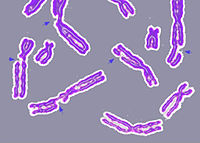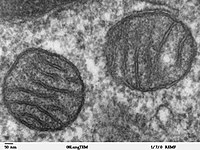
DNA base excision repair genetic risk scores, oxidative balance, and incident, sporadic colorectal adenoma
Sign Up to like & getrecommendations! Published in 2017 at "Molecular Carcinogenesis"
DOI: 10.1002/mc.22620
Abstract: Associations of individual base excision repair (BER) genotypes with colorectal adenoma risk are unclear, but likely modest. However, genetic risk scores (GRS) that aggregate information from multiple genetic variants might be useful for assessing genetic… read more here.
Keywords: risk; adenoma; incident sporadic; base excision ... See more keywords

Impact of PARP1, PARP2 & PARP3 on the Base Excision Repair of Nucleosomal DNA.
Sign Up to like & getrecommendations! Published in 2020 at "Advances in experimental medicine and biology"
DOI: 10.1007/978-3-030-41283-8_4
Abstract: DNA is constantly attacked by different damaging agents; therefore, it requires frequent repair. On the one hand, the base excision repair (BER) system is responsible for the repair of the most frequent DNA lesions. On… read more here.
Keywords: parp1 parp2; base excision; dna; excision repair ... See more keywords

Base Excision Repair in Chromatin and the Requirement for Chromatin Remodelling.
Sign Up to like & getrecommendations! Published in 2020 at "Advances in experimental medicine and biology"
DOI: 10.1007/978-3-030-41283-8_5
Abstract: Base excision repair (BER) is a co-ordinated DNA repair pathway that recognises and repairs chemically modified bases and DNA single strand breaks. It is essential for the maintenance of genome integrity and thus in the… read more here.
Keywords: chromatin remodelling; base excision; chromatin; excision repair ... See more keywords

Mitochondrial base excision repair positively correlates with longevity in the liver and heart of mammals
Sign Up to like & getrecommendations! Published in 2020 at "GeroScience"
DOI: 10.1007/s11357-020-00158-4
Abstract: Damage to DNA is especially important for aging. High DNA repair could contribute, in principle, to lower such damage in long-lived species. However, previous studies showed that repair of endogenous damage to nuclear DNA (base… read more here.
Keywords: longevity; base excision; dna; ber ... See more keywords

Enhancing Base Excision Repair of Mitochondrial DNA to Reduce Ischemic Injury Following Reperfusion
Sign Up to like & getrecommendations! Published in 2018 at "Translational Stroke Research"
DOI: 10.1007/s12975-018-0680-5
Abstract: We hypothesize that enhancing mitochondrial base excision repair (BER) capability in brain will reduce reperfusion-associated ischemic brain injury. Post-stroke reperfusion was modeled in mice via transient filament occlusion of the middle cerebral artery (60 min) (transient… read more here.
Keywords: base excision; following reperfusion; excision repair; reperfusion ... See more keywords

Initiating base excision repair in chromatin.
Sign Up to like & getrecommendations! Published in 2018 at "DNA repair"
DOI: 10.1016/j.dnarep.2018.08.011
Abstract: The base excision repair (BER) pathway removes modified nucleobases that can be deleterious to an organism. BER is initiated by a glycosylase, which finds and removes these modified nucleobases. Most of the characterization of glycosylase… read more here.
Keywords: base excision; excision repair; glycosylase; modified nucleobases ... See more keywords

PARPs' impact on base excision DNA repair.
Sign Up to like & getrecommendations! Published in 2020 at "DNA repair"
DOI: 10.1016/j.dnarep.2020.102911
Abstract: Poly(ADP-ribosyl)ation is one of immediate cellular responses to DNA damage and is catalyzed by poly(ADP-ribose) polymerases (PARPs). PARP1 is a well-known regulator of DNA repair. Another member of this family, PARP2, was discovered later. The… read more here.
Keywords: base excision; dna repair; repair;

Structural Insights into the Mechanism of Base Excision by MBD4.
Sign Up to like & getrecommendations! Published in 2021 at "Journal of molecular biology"
DOI: 10.1016/j.jmb.2021.167097
Abstract: DNA glycosylases remove damaged or modified nucleobases by cleaving the N-glycosyl bond and the correct nucleotide is restored through subsequent base excision repair. In addition to excising threatening lesions, DNA glycosylases contribute to epigenetic regulation… read more here.
Keywords: structural insights; base excision; mechanism; dna ... See more keywords

Emerging Roles of DNA Glycosylases and the Base Excision Repair Pathway.
Sign Up to like & getrecommendations! Published in 2019 at "Trends in biochemical sciences"
DOI: 10.1016/j.tibs.2019.04.006
Abstract: The base excision repair (BER) pathway historically has been associated with maintaining genome integrity by eliminating nucleobases with small chemical modifications. In the past several years, however, BER was found to play additional roles in… read more here.
Keywords: base excision; emerging roles; excision repair; dna glycosylases ... See more keywords

Chemical Tools for the Study of DNA Repair.
Sign Up to like & getrecommendations! Published in 2022 at "Accounts of chemical research"
DOI: 10.1021/acs.accounts.2c00608
Abstract: ConspectusDNA repair enzymes continuously provide surveillance throughout our cells, protecting the enclosed DNA from the damage that is constantly arising from oxidation, alkylating species, and radiation. Members of this enzyme class are intimately linked to… read more here.
Keywords: dna repair; base excision; study dna; chemical tools ... See more keywords

Development of a Cell-Based Assay for Measuring Base Excision Repair Responses
Sign Up to like & getrecommendations! Published in 2017 at "Scientific Reports"
DOI: 10.1038/s41598-017-12963-7
Abstract: Base excision repair (BER) is the predominant pathway for coping with most forms of hydrolytic, oxidative or alkylative DNA damage. Measuring BER capacity in living cells is valuable for both basic science applications and epidemiological… read more here.
Keywords: development cell; base excision; excision repair; cell based ... See more keywords